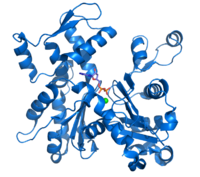
Photo from wikipedia
Aim To evaluate different parameters in differentiating intestinal BD from CD. Methods The medical records of inpatients with intestinal BD and CD were retrospectively reviewed. The univariate value of different… Click to show full abstract
Aim To evaluate different parameters in differentiating intestinal BD from CD. Methods The medical records of inpatients with intestinal BD and CD were retrospectively reviewed. The univariate value of different parameters was analyzed, respectively. A differentiation model was established by pooling all valuable parameters together. Diagnostic efficacy was evaluated, and a receiver operating curve (ROC) was plotted. Results Forty-two BD patients and ninety-seven CD patients were reviewed. Demographic and clinical parameters that showed significant value included diarrhea, fever, perianal disease, oral ulcers, genital ulcers, skin lesions, and musculoskeletal lesions. Endoscopic parameters reaching clinical significance included multiple-site lesions, lesions confined to the ileocecal region, longitudinal ulcers, round or oval ulcers, punch-out ulcers, ulcers with discrete margin, ulcer size > 2 cm, stricture of bowel, and anorectal involvement. Radiologic parameters aiding the differentiation included involvement segments ≤ 3, asymmetrical pattern of involvement, intraluminal pseudopolyp formation, target sign, stricture with proximal dilation, comb sign, and fistula. The sensitivity, specificity, accuracy, positive predictive value, and negative predictive value of the differentiation model were 90.5%, 93.8%, 92.8%, 86.4%, and 95.8%, respectively. The cutoff value was 0.5 while the area under the ROC curve was 0.981. Conclusion The differentiation model that integrated the various parameters together may yield a high diagnostic efficacy in the differential diagnosis between intestinal BD and CD.
Journal Title: Gastroenterology Research and Practice
Year Published: 2017
Link to full text (if available)
Share on Social Media: Sign Up to like & get
recommendations!